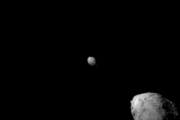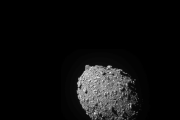
DART spacecraft conducted the world’s first full-scale planetary defense test
27. 09. 2022
Today (September 27, 2022) at 1:14 AM CEST NASA’s Double Asteroid Redirection Test (DART) spacecraft successfully conducted the world’s first full-scale planetary defense test by impacting asteroid moonlet Dimorphos (Greek for “two forms”), which orbits a larger asteroid named Didymos (Greek for “twin”). The kinetic impact demonstrated one possible method of asteroid deflection technology. As a part of an international planetary defense strategy, the DART mission proved that a spacecraft can autonomously navigate to a target asteroid and intentionally collide with it to alter its orbit. DART is accompanied by a small Italian sub-spacecraft called LICIACube, which observed the impact from a distance.
The target of the mission is a binary asteroid system, which consists of a larger asteroid named Didymos (780 meters in diameter) and a smaller, orbiting asteroid moonlet named Dimorphos (160 meters). The asteroid system currently poses no threat to Earth but is an ideal natural laboratory to safely test an asteroid deflection method known as kinetic impact.
As DART impacted the Dimorphos moonlet with a velocity of 6.15 kilometers per second, the kinetic energy delivered by the spacecraft altered its orbit around the larger Didymos. The orbit of the entire system around the Sun remained unchanged and the system thus continue to pose no threat to the Earth. The DART collision is expected to shorten Dimorphos’ orbital period by several minutes. Telescopic observations performed in the following weeks will precisely measure the orbital period change and determine how efficient the DART impact was. Scientists from the University of Helsinki take part in this observation campaign using the Nordic Optical Telescope on La Palma, Spain.
The European Space Agency is preparing a complementary mission named Hera, which will arrive to the Didymos system in 2027. Instead of impacting the asteroids it will rendezvous and conduct detailed scientific characterization of the asteroid pair and precisely measure their mass, size, composition, and internal structure. The Hera spacecraft will carry a small sub-spacecraft named Milani, equipped with a Finnish—Czech miniaturized hyperspectral imager called ASPECT. ASPECT will provide crucial data about the mineral composition of both asteroids.
Planning and data analyses of DART and Hera missions are actively contributed by Czech researchers of the Astronomical Institute of the Czech Academy of Sciences, Institute of Geology of the Czech Academy of Sciences, and Brno University of Technology.
DART is a NASA mission managed by Johns Hopkins Applied Physics Laboratory. Both DART and Hera are testing new technologies and provide important data to enhance our modeling and predictive capabilities, and help us better prepare for an asteroid that might pose a threat to the Earth, should one be discovered.
Supplementary information from recent press release by ASU AV ČR.
Read also
- During the Researches’ Night, you experience science with all your senses
- Archaeologists uncover a unique Stone Age building on the outskirts of Prague
- Protein named after the goddess Maia plays a key role in the origin of life
- The Biology Centre of the CAS will strengthen plant research
- The largest Czech telescope is fifty-five years old and still in top condition
- Travellers in ancient times used guidebooks, which can still inspire today
- When plasma is unstable: physicists tested sudden energy collapses in a tokamak
- Scientists offer a blueprint for sustainable food systems not addicted to growth
- International research centre focused on environmental and technology ethics
- Soil fungi help plants take up phosphorus, but pesticides destroy the symbiosis
Contacts for Media
Markéta Růžičková
Public Relations Manager
+420 777 970 812
Eliška Zvolánková
+420 739 535 007
Martina Spěváčková
+420 733 697 112



